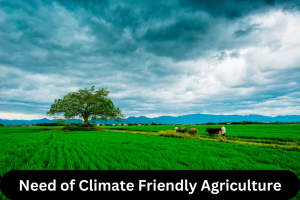ForumIAS announcing GS Foundation Program for UPSC CSE 2025-26 from 27th May. Click Here for more information.
Source-This post on Need of Climate Friendly Agriculture has been created based on the article “To ensure a hunger-free nation, protect soil” published in “The Indian Express” on 29 April 2024.
UPSC Syllabus-GS Paper-3- Issues related to Direct and Indirect Farm Subsidies and Minimum Support Prices.
Context– Earth Day was first observed on 22 April 1970 to demonstrate support for environmental protection. Since then, many conferences of Parties (COPs) meetings have been held, with the latest being COP 28 in Dubai, UAE, in November-December 2023. This is significant because agriculture was included in the agreement for the first time.
However, India, unlike many G20 countries such as the US and China, did not sign the agreement. The government believed that signing it would require substantial changes in agricultural policies and farming practices. Need of Climate Friendly Agriculture
What are the reasons for the biodiversity loss in India?
1) The increasing human population is a major cause of biodiversity loss on Earth. Humans took over 200,000 years to reach one billion by 1804. The next billion was added in only 123 years by 1927. And now, in less than 100 years, the population has surged from two billion to over eight billion.
This rapid growth has led to the clearing of forests for farming to prevent mass famines and starvation deaths. However, this has resulted in the loss of several species and genetic diversity.
What are the inappropriate policies adopted in agriculture that have harmed the planet?
1) Depleting organic carbon content of the soil-The heavy subsidization of chemical fertilizers, especially urea, has caused imbalanced use of nitrogen (N), phosphate (P), and potash (K) leading to depletion of soil’s organic carbon.
As per the expert, the ideal level of soil organic carbon (SOC) should be between 1.5 to 2 percent. However, more than 60 percent of Indian soils have SOC levels of less than 0.5 percent.
2) Groundwater depletion & emission of carbon– The ground water level in Punjab, Haryana, and Rajasthan is depleting rapidly. This is due to free power for irrigation, fixed prices for crops, and unrestricted purchase of rice, which have encouraged excessive use of groundwater.
This has caused an environmental crisis in these areas, with the water level dropping each year and rice fields releasing carbon at a high rate of nearly 5 tons per hectare.
3) Loss of crop diversity-Faulty agricultural policies are leading to the loss of crop diversity. For ex- in 1960, only 4.8 % of Punjab’s farmland was used for growing rice. Today, it’s over 40 % displacing crops like maize, millets, pulses, and various oilseeds.
Read more- Technologies for sustainable agriculture development
What should be the way forward?
1) Direct Income Transfer-There should be a shift from heavily subsidizing the prices of nitrogen, phosphorus, and potassium to directly giving income to farmers and allowing the market to determine the prices of these nutrients.
However, this requires early preparations such as updating farmers’ land records, knowing the crops they grow, their irrigation methods, and so on.
2) Planet positive policies– There is a need to make food systems resilient to climate change, improve soil health, stop groundwater depletion, significantly lower greenhouse gas emissions, and reward biodiversity with green credits.
Question for practice
List the inappropriate policies adopted in agriculture that have damaged the planet?





